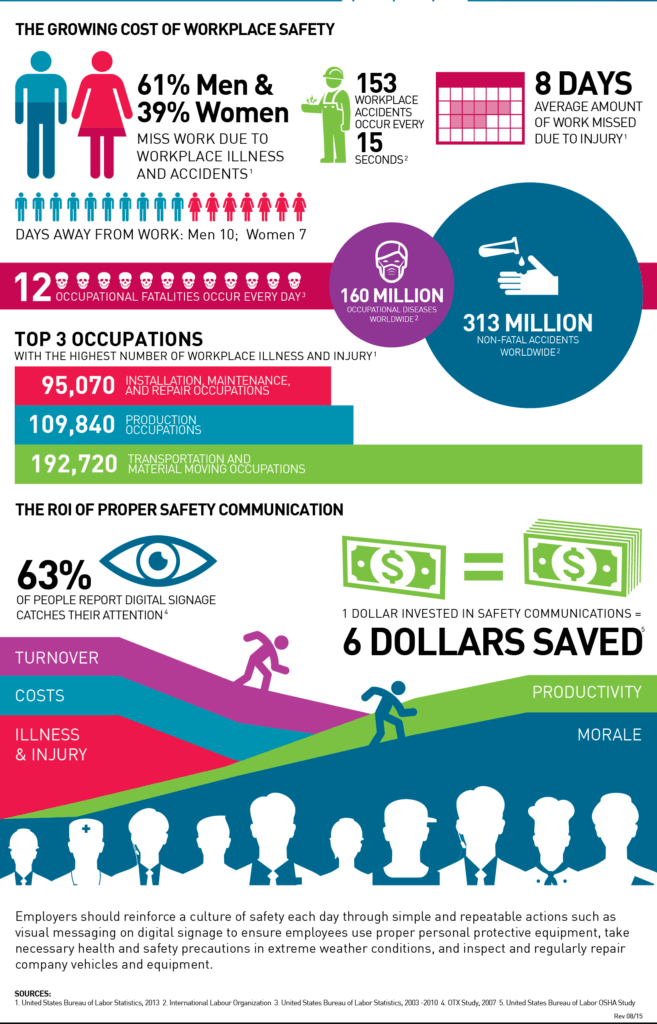Table of contents
Let’s face it, no manager enjoys putting together a safety training program.
However, without one, your employees do not have the tools to deal with a crisis, which could negatively affect your bottom line.
Your workforce is your biggest asset, that’s a given. But, you may be surprised to learn that a healthy workforce can do more than just prevent workers from accidents or falling ill.
A workplace with an efficient safety training program can reduce turnover, improve productivity and morale. In addition, it is the moral thing to do!
Now more than ever, safety is changing on a daily basis due to COVID-19. Therefore, it is paramount that your methods are up to date.
If you fail to carry out a proper safety training program, you can actually harm your business. Simply because small to medium business owners do not have the same resources as large enterprises. Someone gets seriously hurt, and it can have a domino effect.
The following are the implications of an employee taking sick leave:
- Paying out wages for work that is not complete since your employee is home
- Higher cost of business insurance
- Damage to expensive tools or equipment
- Hiring new employees (long process and costly)
- Reduced morale company-wide
- And more.
Therefore, the need for a thorough safety training program is a no-brainer! We’ve put together the steps to take to create a foolproof safety training program that you’ll refer to time and time again.
Want to carry out a proper safety training program?
Create your own customized company app to deliver your workplace safety training program to your employees using their mobile phones with Connecteam!

What is Workplace Safety Training?
Workplace safety training is a process that aims to provide your workforce with knowledge and skills to perform their work in a way that is safe for them and their co-workers.
In addition, an effective workplace safety plan includes instructions and guidelines to identify hazards, report them, and deal with incidents.
You need to encourage a great incident reporting culture so that you can effortlessly create a safer workplace and can identify how your company can continually improve the workplace environment.
When a new incident happens, you have to have a quick method to relay the message to all your employees to avoid the incident from happening a second time. Employees need to be able to easily access old hazard reports so they can learn on the job.
- You should be able to warn and alert your employees to a hazard BEFORE it happens.
- When one happens, you need to be able to handle the situation DURING the incident.
- And then AFTER the incident, you have to be able to easily let the rest of the team know, like about the wet floor so slipping can be avoided.
There is a lot that goes into protecting your employees so you must have a stable process in place.
As an employer, it is your legal (and moral) responsibility to instruct your workers on how to perform in a safe and healthy manner before they even start to work.
Safety training is an integral part of the employee onboarding process but it also requires regular “refresher” safety courses for compliance (and effectiveness). Not only because employee alertness goes down over time, but also because safety protocols change to keep up with changes in equipment, materials, and roles within the business.
Why You Need Workplace Safety Training in Your Business
Beyond the obvious reasons – regulation and moral responsibility – there are plenty of advantages to investing more time and thought in a well-planned workplace safety training program. Here are a few:
- Lower insurance premiums
- Less productivity loss due to illness or injury
- Higher employee satisfaction
- Reduced worker compensation for medical leave due to work-related injuries and illnesses
- Protection from liability lawsuits
- Future incident prevention.

But odds are you’re already convinced and are reading this post to learn how to make your employee safety training program a stellar example of employer diligence.
Cost of Employee Turnover
Employee turnover rate
Total cost to onboard new employee
Total cost of lost productivity
Training Beyond Regulation
Not all workplace safety training courses are the same. For different tasks and industries, there are different safety training requirements [PDF], both in content and training frequency. So there’s really no “one-size-fits-all” when it comes to workplace safety training.
The Occupational Safety and Health Administration’s (OSHA) requirements and state health and safety authorities are the bare minimum. When planning your workplace safety outreach training program, your goal should be to minimize incidents, maximize awareness and alertness, and keep your employees healthy, happy, and productive. Not just comply with regulatory demands.
Download your FREE guide on “6 Pillars for Improving Frontline Employee Retention” ⤵

Steps to an Effective Workplace Safety Training Program
Identify Business Needs
Identify the needs of your business, potential hazards, and training objectives. Then, analyze past incidents and common industry hazards. Figure out which issues need to be addressed through training, and which have other solutions like protective equipment or warning signs.
Include Your Employees
Involve your workforce in developing, implementing, and optimizing the training program. The contribution of managers, supervisors, and workers is crucial. They have the best understanding of how work gets done, and where dangers to their safety and health might be hiding.
Applies To All Roles
Create modular training and testing processes that can be applied to each role in the business according to regulations. For example, knife safety handling instructions are the same for a waiter and fry cook, while fire safety protocols or handling cleaning material might be different for each.
Include Managers
Train managers and supervisors in the safety requirements of their teams. This will allow them to identify issues with employee compliance with safety regulations.

Create Communication Channels
Include communication channels for hazard reporting in your training, so workers know who to contact and how to prevent a potential accident.
Issue Tests
Test your workers with quizzes, surprise inspections. These can help you determine how effective your workplace safety program is before an accident forces you to discover it is not.
Make It Continuous
Provide continuous and easy access to safety training content to let employees refresh their memory when necessary. For example, an employee who was instructed on the safety requirements of operating a certain machine six months ago, and hasn’t touched it since? It is more likely to stay safe if they have the content of the training course readily available for him to review.
Safety Training in 2024
Safety training programs today are very different from those made a decade ago. New technologies are responsible for the most obvious changes in the way we communicate. This affects the way we train and complete tasks.
But keeping up with technological trends is not the only reason your business safety training plan needs to be current to be effective.
Mobile workforce:
More and more businesses employ remote workers as well as deskless workers on the go. These are harder to train than in-house employees.
Solution? Online safety tools and formats that do not require on-site presence.
Contingent workforce:
With the “gig economy” becoming prevalent across all industries, training (including health and safety training for employees) needs to be fast (but thorough).
Solution? Modular online training programs, easily customizable for onboarding.
Workplace diversity:
The global economy is getting more global every year. However, international organizations and businesses employing ex-pats often lack safety training materials in multiple languages.
Solution? Technological tools that allow for quick translation and localization of the training modules.
Make Workplace Safety Training Digital
There’s no doubt that some types of safety training require hands-on demonstrations and are best delivered in person or in a small group. But when it comes to workplace safety training of deskless workers, contingent employees, or a dispersed global workforce – the best choice is mobile learning.
With Connecteam, you can create your own customized company app to deliver your workplace safety training program to your employees using the one device everyone has in 2022 – their mobile phone. And Connecteam allows you to customize the training feature to suit your business needs.
What’s the manager’s benefit?
- Create any type of unique content or process such as onboarding, training, online courses, or a knowledge base with videos, free text, workflows, and quizzes
- Deliver training on the go, without having to gather employees physically
- Offer your team the option to divide their training into parts so they can complete training at their own pace
- Monitor employee progress through the training dashboard and ensure their understanding with quizzes along the way
- The status columns offer clarity on employees’ progress
- Send company-wide updates so everyone knows a new version is available and track who received and read your message to ensure everyone is aligned
What’s the employee’s benefit?
- Complete training right from their mobile phone without having to carry folders or gather together at different places
- Can manage their training on the go and at their own pace
- Easy and intuitive process
- Always have access to up to date material
While the safety manuals in your business might be collecting dust somewhere, searchable and easy-to-use training materials help make sure your employees have the knowledge they need at their fingertips.
The #1 Employee Management App for Workplace Safety Training
Provide your employees with all of the training resources they need to do their job effectively, efficiently and most importantly, safely.
Safety Training in the Workplace During Crisis Management
Whenever your company must deal with a crisis, including a cyber-attack, rumors, organizational misdeeds, workplace violence, man-made disasters, or a global pandemic like COVID-19, you must get ahead to manage the situation. With Connecteam, you can easily adapt and respond to evolving conditions, making sure your team is on the same page.
Give your team every resource needed to understand the situation – especially by creating dedicated templates that include videos, text, files, and images. your employees should have instant access to:
- Relevant information regarding the virus.
- Insulation guidelines
- Symptoms of infection
- Links to the World Health Organization materials and more. Share some of the World’s Health Organization’s recent publications via a link in the app.
- OSHA training resources.
- Learning resources from the National Safety Council.
Additionally, you would have new procedures in place to prevent and deal with the coronavirus. Create a dedicated library in the app for all crisis-related procedures, such as Convergence Guidelines, Work Transportation, Disinfection of Work Areas, Conferences Attendance, Tutorials, Flight Policies, Vacation Procedure Update, FAQs, etc.
Take it a step further and update your emergency contact list in the app.
Above all else, provide continuous communication:
- Chat: Create a dedicated chat channel with key team members from Human Resources ready to address questions.
- Create a dedicated chat channel for Q&A.
- Updates: consider keeping the team up to date with key updates such as:
- General updates regarding the company’s preparations and actions to protect the team.
- Regular updates from the CEO on the company’s way of conduct regarding the virus.
- Other key updates on customers and company activity with respect to working with partners, etc.
- Operational updates: if for example, you are moving to ‘work from home’ mode, or if you go back to routine, keep the team posted on operational changes.
You must apply the above examples in preparation for any crisis.
Make Training Digital
Connecteam makes safety training flexible, interactive and accessible at all times. Make sure all your employees have access to training material and professional skills at the click of a button
